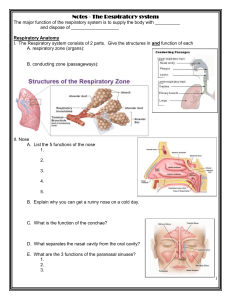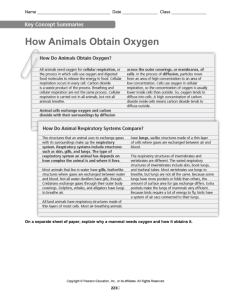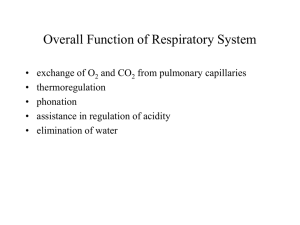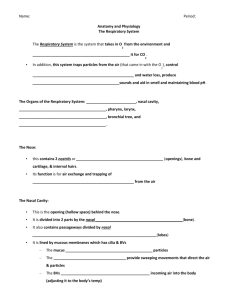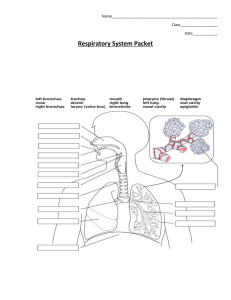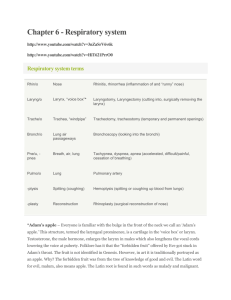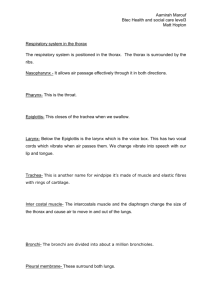A & P Respiratory System
advertisement
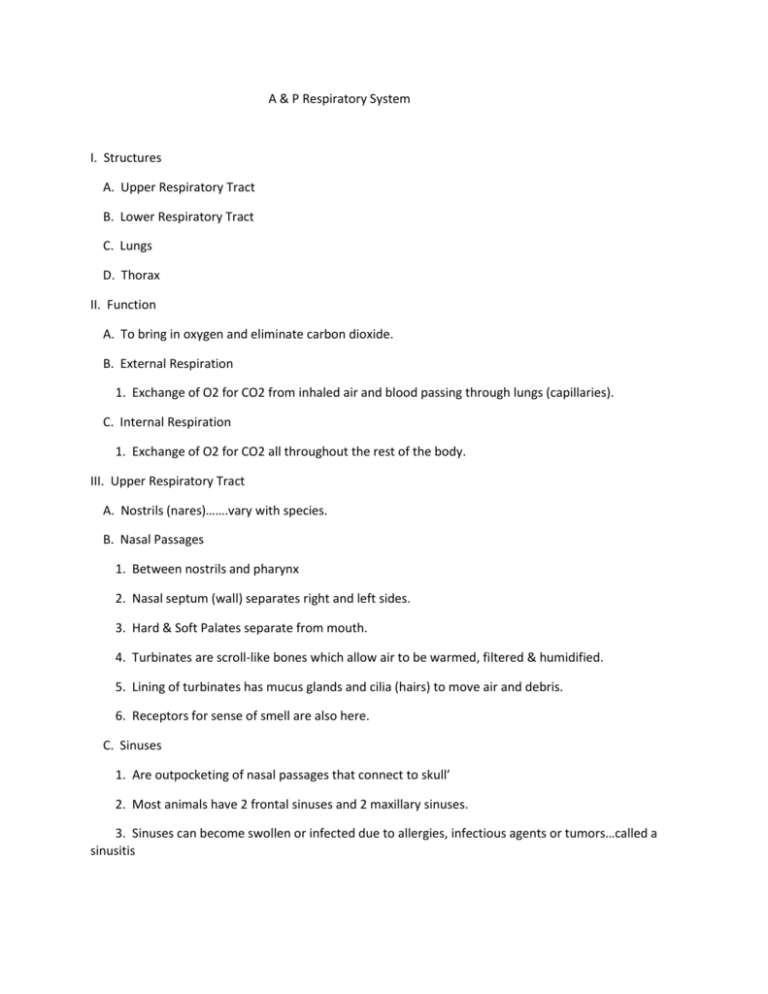
A & P Respiratory System I. Structures A. Upper Respiratory Tract B. Lower Respiratory Tract C. Lungs D. Thorax II. Function A. To bring in oxygen and eliminate carbon dioxide. B. External Respiration 1. Exchange of O2 for CO2 from inhaled air and blood passing through lungs (capillaries). C. Internal Respiration 1. Exchange of O2 for CO2 all throughout the rest of the body. III. Upper Respiratory Tract A. Nostrils (nares)…….vary with species. B. Nasal Passages 1. Between nostrils and pharynx 2. Nasal septum (wall) separates right and left sides. 3. Hard & Soft Palates separate from mouth. 4. Turbinates are scroll-like bones which allow air to be warmed, filtered & humidified. 5. Lining of turbinates has mucus glands and cilia (hairs) to move air and debris. 6. Receptors for sense of smell are also here. C. Sinuses 1. Are outpocketing of nasal passages that connect to skull’ 2. Most animals have 2 frontal sinuses and 2 maxillary sinuses. 3. Sinuses can become swollen or infected due to allergies, infectious agents or tumors…called a sinusitis D. Pharynx (throat) 1. Common passageway for respiratory and digestive tracts. 2. Opens dorsally into esophagus and ventrally into larynx. 3. Epiglottis controls the flow of air or food and water. E. Larynx (voice box) 1. Connects pharynx to trachea. 2. Hyoid bones support the larynx. 3. Pattern and number of cartilages in larynx varies with species. a. Vocal cords are attached to inside of larynx to the arytenoid cartilages. b. Muscle tension determines voice. c. Ex: Howler Monkeys have a well developed vocal cord system. 4. Some non-ruminants have false “ vocal cords” which are a 2nd set of bands or folds a. These are not involved in voice production. b. These are where a condition in horses called “ Roaring “ occurs. 1) Roaring is a congenital paralysis of the larynx which is treated surgically. 5. Larynx has 3 main functions……. a. voice production, prevents aspiration and controls airflow to lungs. 6. The Glottis is the opening into the larynx. a. A cough is produced by closing the glottis and contracting respiratory muscles. b. Same procedure happens when straining for parturition, urination or defecation. 7. Endotrachael intubation for anesthesia is done via the glottis. F. Trachea (windpipe) 1. Composed of cartilage rings with smooth muscle connecting each ring dorsally. 2. Extends from the larynx into the thorax where it divides into Right & Left bronchi. 3. Mucus glands and cilia line the trachea just like the nostrils. 4. Trachael Collapse a. Occurs in small dogs and cats….idiopathic cause…..treat medically or surgically. IV. Lower Respiratory Tract A. From bronchi to alveoli….the Bronchial Tree 1. Right & Left Bronchi to bronchioles to alveoli. B. Alveoli (like clusters of grapes) 1. Tiny, thin-walled sacs surrounded by capillaries. 2. Where oxygen is exchanged for carbon dioxide. 3. Asthma is a disease that causes the bronchial tree to be overly sensitive & constricts. a. Signs are coughing, wheezing & often severe dyspnea. b. Treated with bronchodialators, steroids & antihistamines. C. Lungs 1. Base of the lungs lie directly on the diaphragm (muscle separating thorax and abdomen). 2. Mediastinum separates lungs. 3. Lungs have distinct lobes… a. Most animals have Left cranial & caudal lobes; and Right cranial, middle, caudal & accessory. b. Horses have Left all one lobe and Right all one lobe plus an accessory lobe. 4. Lungs are light and “spongy”. a. This can be used to see if a newborn ever took a breath or if animal drowned. 5. Infection called “pneumonia” or sometimes “bronchitis”. 6. Thorax and lungs covered by membrane called “pleura”…..infection is pleuritis and is painful. 7. Negative Intrathoracic Pressure a. Air pressure inside the thorax is less than outside air…which allows the lungs to inflate. 8. Pneumothorax a. “Extra” air in the thorax due to an injury and causes lung to collapse. b. Treat by drawing off extra air and allowing lung to re-inflate. 9. Respiratory Volumes a. Tidal Volume = amount of air inspired and expired during one breath. b. Residual Volume = amount of air remaining in lungs after maximum expiration. 10. Control of Breathing a. Does not require conscious effort generally. b. Medulla oblongata portion of brain (brain stem) controls respiration. c. Carotid Body Reflex…..stimulates respiration when O2 decreased. d. Blood pH and CO2 are also linked. 1) When CO2 decreases……pH of blood increases…..so respiration decreases 2) When CO2 increases…..pH of blood decreases……so respiration increases to remove CO2. 11. Hiccups a. Spasmodic contractions of diaphragm with sudden closure of the glottis….usually temporary.
